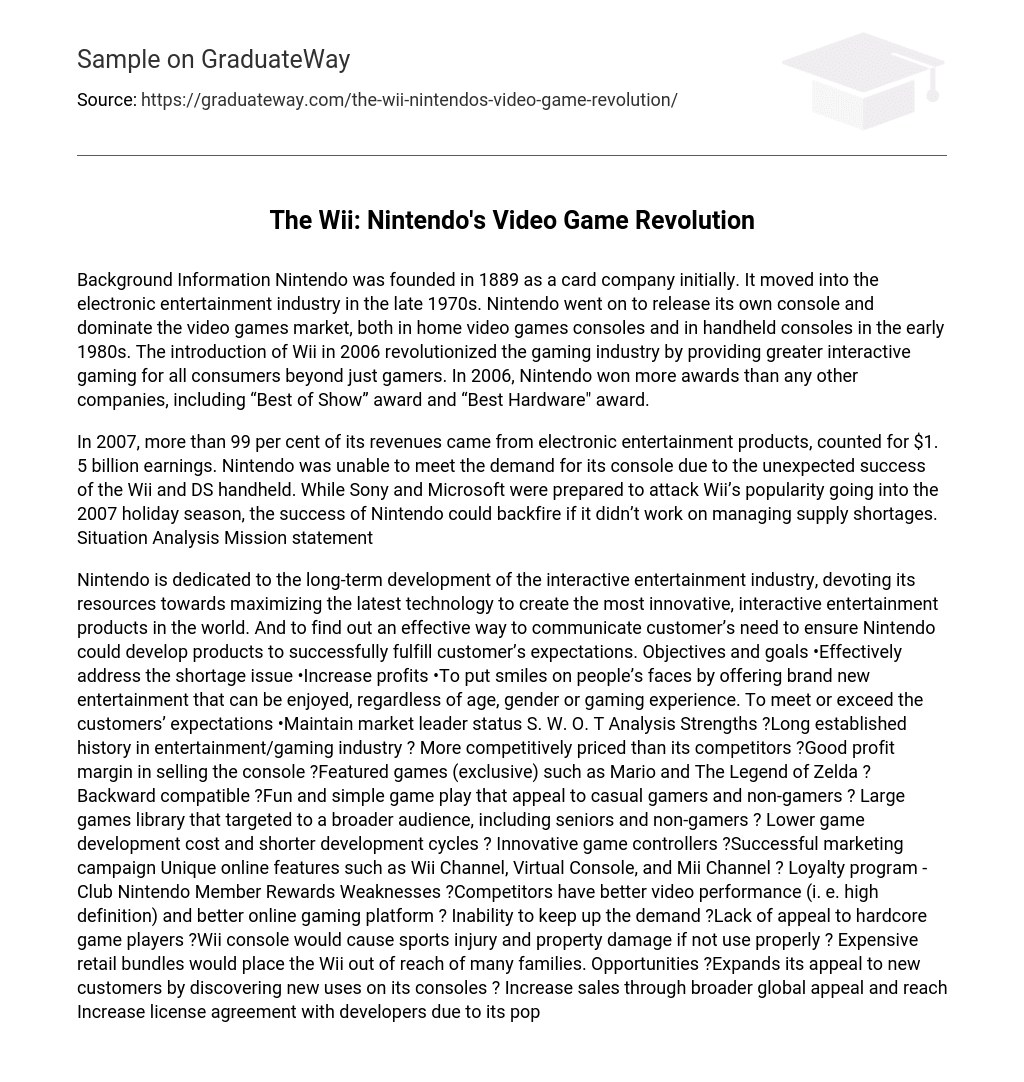Background Information Nintendo was founded in 1889 as a card company initially. It moved into the electronic entertainment industry in the late 1970s. Nintendo went on to release its own console and dominate the video games market, both in home video games consoles and in handheld consoles in the early 1980s. The introduction of Wii in 2006 revolutionized the gaming industry by providing greater interactive gaming for all consumers beyond just gamers. In 2006, Nintendo won more awards than any other companies, including “Best of Show” award and “Best Hardware” award.
In 2007, more than 99 per cent of its revenues came from electronic entertainment products, counted for $1. 5 billion earnings. Nintendo was unable to meet the demand for its console due to the unexpected success of the Wii and DS handheld. While Sony and Microsoft were prepared to attack Wii’s popularity going into the 2007 holiday season, the success of Nintendo could backfire if it didn’t work on managing supply shortages. Situation Analysis Mission statement
Nintendo is dedicated to the long-term development of the interactive entertainment industry, devoting its resources towards maximizing the latest technology to create the most innovative, interactive entertainment products in the world. And to find out an effective way to communicate customer’s need to ensure Nintendo could develop products to successfully fulfill customer’s expectations. Objectives and goals •Effectively address the shortage issue •Increase profits •To put smiles on people’s faces by offering brand new entertainment that can be enjoyed, regardless of age, gender or gaming experience. To meet or exceed the customers’ expectations •Maintain market leader status S. W. O. T Analysis Strengths ?Long established history in entertainment/gaming industry ? More competitively priced than its competitors ?Good profit margin in selling the console ?Featured games (exclusive) such as Mario and The Legend of Zelda ? Backward compatible ?Fun and simple game play that appeal to casual gamers and non-gamers ? Large games library that targeted to a broader audience, including seniors and non-gamers ? Lower game development cost and shorter development cycles ? Innovative game controllers ?Successful marketing campaign Unique online features such as Wii Channel, Virtual Console, and Mii Channel ? Loyalty program – Club Nintendo Member Rewards Weaknesses ?Competitors have better video performance (i. e. high definition) and better online gaming platform ? Inability to keep up the demand ?Lack of appeal to hardcore game players ?Wii console would cause sports injury and property damage if not use properly ? Expensive retail bundles would place the Wii out of reach of many families. Opportunities ?Expands its appeal to new customers by discovering new uses on its consoles ? Increase sales through broader global appeal and reach Increase license agreement with developers due to its popularity ? Only few dominant manufactures ?The concept of video game had been changed since the Wii launched in the market Threats ?Intense competition and attack from Xbox 360 and PS3 ?Emergence of new video games devices such as iPhone ?Roms and emulator – ability to play consoles games on computers ? Console hacking – Playing illegal or pirated game copies without paying a fee ? Bad economic condition ?Adverse customer feedback due to shortage problems (i. e. bad publicity) ? Consumer could turn to alternative consoles because of Grey-market trading





